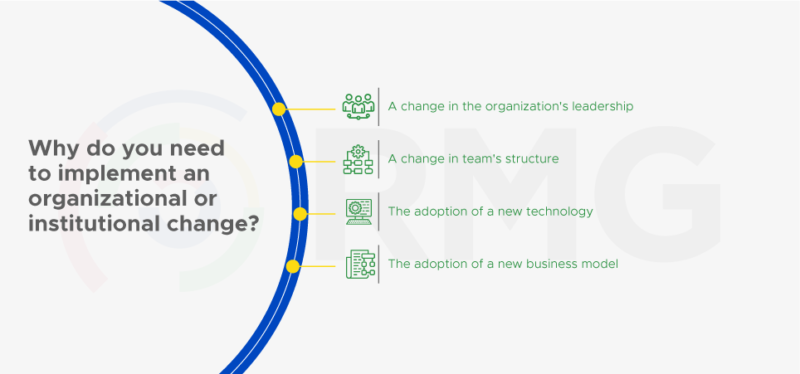What are the stages of institutional or organizational change?
Perhaps you are starting to wonder whether you need to implement organizational change in your workplace? What are the necessary steps for that?
The “Lewin” model is one of the most important international models that describe the stages of organizational change, it is a model that was developed by the scientist Kurt Lewin in the mid-forties of the twentieth century, despite the age of this model, it has proven its effectiveness to this day and is considered a cornerstone of any organizational change process.
Lewin defines 3 stages of change:
1- Unfreeze: At this stage, what needs to be changed is determined, and ensuring that there is strong support from senior management for the change, the need for change must also be confirmed, and doubts and fears regarding implementing the change process must be managed and understood, this stage usually corresponds to planning within existing management methodologies.
2- Change: In this stage, procedures are implemented by which systems and activities are modified, and communication is carried out periodically with all stakeholders to clarify the changes, refute rumors, and reduce the process of change resistance, success at this stage requires people to be involved in it.
3- Refreezing: Here changes are integrated into the organization’s culture, and work to develop new ways to maintain change and make it sustainable, and support is provided to teams to be able to keep pace with changes, and it is important to celebrate success.
What about organizational or institutional change in government entities?
Some may believe that organizational change is linked to achieving profit and maintaining market share, and is therefore limited to for-profit enterprises and the private sector, in fact, organizational change is applied even in non-profit institutions, whether they are government entities or civil society organizations such as charities and development organizations.
Steps for organizational change
When considering organizational change in a government entity, the following steps must be followed:
- Define your goal for change, are you seeking to develop new services for the entity’s beneficiaries? is the goal to reduce waste or reduce office bureaucracy? perhaps the goal is to improve communication with beneficiaries?
- Study the influencing environmental factors, change, as we mentioned, is linked to the internal and external environment, so it would be useful to analyze these factors and how they affect the organization’s current and future activity.
- Identify the stakeholders, who are the ones involved in the change? who is responsible for it? who will benefit from it? at the same time, who will be harmed by this change? and who may oppose the change and seek to undermine it? it is essential to precisely identify the stakeholders while determining the relationship of each and their stance.
- Establish phased steps for change, we all know that change does not happen overnight, it may require you to create a time plan with different phases with what needs to be accomplished in each phase.
- Identify the resources needed, change may require certain financial or human resources from you, and may require using new technology in business, you have to determine that and also determine the sources of these resources.
- Make more communication, we all know about the state of rumors that hit the workplace when a new change is made, your role is to reduce these rumors as much as possible as they may create enemies for change, and this requires intensive communication with everyone about the change that is taking place and what its goals are.
- Evaluate periodically, it is not enough to have a good change management plan, as you may encounter unexpected circumstances, it is important to evaluate the stages of work periodically and measure the results at each stage.
- Celebrate success! Many people neglect to celebrate success at the end, but, if you don’t celebrate now, how will you motivate others for the coming change?
There is no doubt that government entities face special challenges in the previous steps, administrative complexity makes the decision-making process difficult, and the diversity of beneficiaries of entity services from different segments of citizens makes change a process that is not easy, however, with good planning and following the above steps, you can make the change process enjoyable and rewarding at the same time.
What are the challenges facing institutional or organizational change?
Change resistance is the biggest challenge facing organizational change, which is represented by those involved in the change process rejecting change procedures or taking steps against them, the reason for refusing to change is usually the fear of losing benefits, such as senior management believing that the change will lose their authority and powers, or employees believing that the change will limit the number of employees and lose their jobs, or even the belief of service beneficiaries that the change will make services more expensive or difficult to obtain.
Another challenge that can face organizational change is the challenge of poor planning, such as planning large goals within a short period, or not involving appropriate resources in the change, and not taking the surrounding circumstances into consideration.
At the same time, many managers fail to realize the different aspects of the change process, as expert management consultant Peter Drucker says, “Culture eats strategy for breakfast,” referring to the impact of the organization’s culture on the success and failure of strategies by not giving it the necessary importance, in fact, most managers give little importance to the culture of the organization, and assume that adapting to the change process is inevitable, even if it takes time, thus, they make mistakes in managing the change process and lead it to failure without knowing that.
So, how can these challenges be avoided?
The manager’s experience certainly plays a major role in the ability to avoid the challenges that will face the change process, experienced managers will have a greater ability to distinguish the obstacles that stand in the way of a successful change process and to overcome these obstacles.
In addition to experience, the importance of dealing with change comes from an administrative perspective, this requires that we do not consider change as a spontaneous matter and an independent event, but rather as an activity that must be subject to management according to its well-known methodology and tools, and here we can apply change management as follows:
1- Planning: The required change must be planned, strategic and operational objectives must be set, in addition to the analysis of internal and external environmental factors and entity factors, including decision-makers and stakeholders.
2- Organizing: Here, the necessary resources for the change process are allocated, including human, financial, and other resources, and the relationship between these resources and the rest of the entity’s departments is determined, in addition to determining the management tools used, powers, and other reporting models.
3- Follow-up and guidance: This stage is concerned with following up the change process through monitoring, reports, measuring results and comparing them with plans, in addition to directing teams to take the necessary steps to keep pace with the change process and overcome any obstacles that may face the work.
4- Evaluation: At this stage, the results are evaluated and the extent of success in achieving the goals is determined, in addition to evaluating the method of work, resources allocation, studying both successful and failed experiences, in addition to preparing a report on the lessons learned.
Although the previous steps seem easy in theory, but their application requires high experience and advanced skill, whether in analysis and research or in decision-making and strategic management.
For this reason, organizations often hire managers specialized in the field of change management to lead the change or development process or to support managers in other departments.

How can I develop my change management skills?
Of course, you can work on developing this skill even if you are not a professional practitioner of it, those interested can pursue postgraduate studies and obtain a master’s degree in the field of change management, they can also participate in multiple training programs dedicated to change management and obtain professional certificates in this field, the most important of these programs are:
- Certified Change Management Professional
- Change Management Specialist
- Certified Problem and Change Manager














